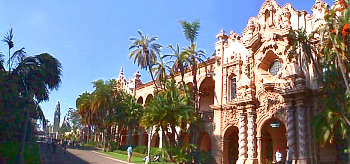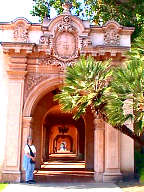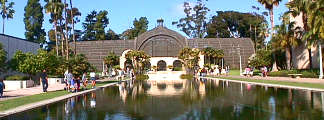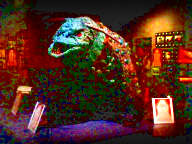Balboa Park
Museum district
San Diego, CA
January 11, 2003
We wound down our trip through California with a visit to the fabulous city of San
Diego. A person could spend weeks, even months, in and around this coastal metropolis
without seeing everything of interest. However, there is a special bright spot in all
this beauty. Up in the hills north of downtown lies a large park. This is
perhaps the most fantastic 1 and 1/2 square miles in California outside of Disneyland. Home to 15 museums, various performing art centers and international
culture organizations as well as the famed San Diego Zoo; Balboa Park boasts of
being the largest urban cultural park in the nation. We spent several days
wandering the streets surrounded by
wound down our trip through California with a visit to the fabulous city of San
Diego. A person could spend weeks, even months, in and around this coastal metropolis
without seeing everything of interest. However, there is a special bright spot in all
this beauty. Up in the hills north of downtown lies a large park. This is
perhaps the most fantastic 1 and 1/2 square miles in California outside of Disneyland. Home to 15 museums, various performing art centers and international
culture organizations as well as the famed San Diego Zoo; Balboa Park boasts of
being the largest urban cultural park in the nation. We spent several days
wandering the streets surrounded by  some of the most impressive architecture I have
every seen. Understanding the need to keep these articles short, I will
only touch
on various aspects of our time there. For me, the most spectacular part of
the park were the buildings that house the museums and other centers. They
were created for the famous 1915-16 Panama-California Exposition, celebrating the
opening of the Panama canal, with substantial additions for the 1935-36
California Pacific-International Exposition, held to boost the local economy
during the depression.
some of the most impressive architecture I have
every seen. Understanding the need to keep these articles short, I will
only touch
on various aspects of our time there. For me, the most spectacular part of
the park were the buildings that house the museums and other centers. They
were created for the famous 1915-16 Panama-California Exposition, celebrating the
opening of the Panama canal, with substantial additions for the 1935-36
California Pacific-International Exposition, held to boost the local economy
during the depression. Most of the
art organizations along Balboa Park's famous
El Prado pedestrian walkway are housed in magnificent Spanish Colonial revival
style buildings. In contrast, the buildings around the Pan American Plaza at the
southern end of the park were created for the 1935 Exposition and present a fascinating
architectural history of the Southwest, from early Aztec influence through the
Mexican style. We wandered down the long arched walkways and peered into the many
courtyards. Flowers abounded from every corner. Here and there was
some little treasure of art set off in its own world which seemed to be
perfectly balanced to compliment it. Add to this the typical bright, warm,
sunny day with a balmy breeze drifting across the corridors and we had the absolutely
perfect day. Fantastic architecture and wonderful museums were not the only
attractions.
Most of the
art organizations along Balboa Park's famous
El Prado pedestrian walkway are housed in magnificent Spanish Colonial revival
style buildings. In contrast, the buildings around the Pan American Plaza at the
southern end of the park were created for the 1935 Exposition and present a fascinating
architectural history of the Southwest, from early Aztec influence through the
Mexican style. We wandered down the long arched walkways and peered into the many
courtyards. Flowers abounded from every corner. Here and there was
some little treasure of art set off in its own world which seemed to be
perfectly balanced to compliment it. Add to this the typical bright, warm,
sunny day with a balmy breeze drifting across the corridors and we had the absolutely
perfect day. Fantastic architecture and wonderful museums were not the only
attractions.  Balboa Park is also renowned for its horticultural treasures on its 1200 acre
manicured landscape. Its eight gardens, which include its internationally
recognized Japanese garden and its award winning rose garden, transformed these once
desert like hillsides into an emerald oasis made up of thousands of flowers, and
other plants, some exotic, and some common to this part of the
country. For the more exotic, there is one of the world's largest
Balboa Park is also renowned for its horticultural treasures on its 1200 acre
manicured landscape. Its eight gardens, which include its internationally
recognized Japanese garden and its award winning rose garden, transformed these once
desert like hillsides into an emerald oasis made up of thousands of flowers, and
other plants, some exotic, and some common to this part of the
country. For the more exotic, there is one of the world's largest wood
lath structures. Built in 1915, it contains over 2100 permanent tropical
plants along with seasonal floral and plant displays, including, would you
believe, a carnivorous plant bog. No insects around this place. As
we traveled down the walkway we had to pick and choose between all the
exhibits. We decided to check out the Museum of Photographic Arts.
wood
lath structures. Built in 1915, it contains over 2100 permanent tropical
plants along with seasonal floral and plant displays, including, would you
believe, a carnivorous plant bog. No insects around this place. As
we traveled down the walkway we had to pick and choose between all the
exhibits. We decided to check out the Museum of Photographic Arts.  In the 1960s San Diego was called "the movie stepsister". A newspaper
article noted that San Diego was often used but never represented in the
movies. Balboa Park could easily be
transformed into a South American republic or someone's castle. The Hotel
del Coronado has often appeared as Florida. Fallbrook looked enough like
the French Countryside for several films. San Diego, which is the 7th largest
metropolitan area in the United States, offers great opportunity for film makers.
Within a short time you can drive from the ocean to a desert area or
into the mountains. Most any terrain needed can be found in the immediate
area. During the silent era San Diego was used by at least 30 movie
companies for countless movies. The park was used to represent a Florida mansion
in Citizen Kane and a castle in India for the movie "The Rains
Came". The museum was filled with old memorabilia, such as dresses
worn by leading ladies, and of course the large old posters of film that somehow
were related to the San Diego area.
In the 1960s San Diego was called "the movie stepsister". A newspaper
article noted that San Diego was often used but never represented in the
movies. Balboa Park could easily be
transformed into a South American republic or someone's castle. The Hotel
del Coronado has often appeared as Florida. Fallbrook looked enough like
the French Countryside for several films. San Diego, which is the 7th largest
metropolitan area in the United States, offers great opportunity for film makers.
Within a short time you can drive from the ocean to a desert area or
into the mountains. Most any terrain needed can be found in the immediate
area. During the silent era San Diego was used by at least 30 movie
companies for countless movies. The park was used to represent a Florida mansion
in Citizen Kane and a castle in India for the movie "The Rains
Came". The museum was filled with old memorabilia, such as dresses
worn by leading ladies, and of course the large old posters of film that somehow
were related to the San Diego area.